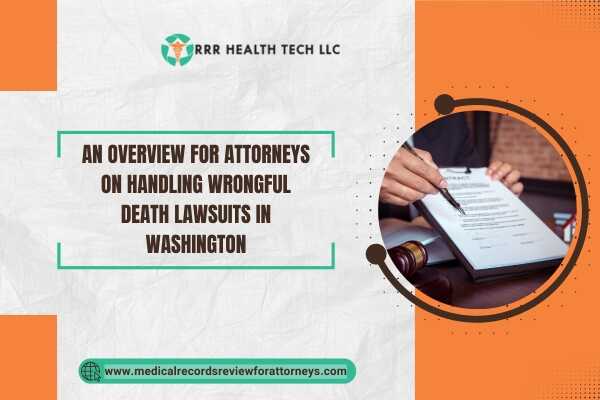
Introduction
Wrongful death lawsuits in Washington State fall under personal injury law. A claim of wrongful death occurs when a person dies because someone else was negligent or did something wrong. Attorneys who represent families in these cases of death must understand the details of wrongful death claims. In this article, we will examine Washington’s wrongful death lawsuits in detail while paying special attention to the medical record review for forming a strong case.
What is a Wrongful Death Lawsuit?
Definition and Legal Framework
• Definition – A wrongful death lawsuit is case filed based on allegation of death of an individual due to negligence or wrongdoing of another individual.
• Legal Basis – Under the Washington statute, a claim for wrongful death is based on the death resulting from the wrongful act, neglect or defaults of another person.
Key Elements of a Wrongful Death Claim
The following criteria need to be fulfilled for a wrongful death lawsuit to be successful:
- Duty of care: The defendant must have an established duty of care towards the deceased.
- Breach of duty: The defendant must have breached the duty by way of some negligent act.
- Causation: The death occurred as a result of the breach of duty cited.
- Damages: Costly consequences were incurred by the surviving family members.
Who Is Eligible To File A Wrongful Death Claim?
Eligibility Criteria
• Personal Representative: The representative of the deceased’s estate in Washington is charged with filing the claim. An executor named in a will or court-appointed person may take on this role.
• Benefits: The spouse, domestic partner, children, parents, or siblings of a deceased person stand to receive damages awarded in a wrongful death claim.
Claim Types for Wrongful Deaths
Economic and Non-Economic Damages
• Economic Damages: These include quantifiable losses such as:
• Medical expenses before death.
• Funeral and burial expenses.
• Losing financial support.
• Value of household services offered by the deceased.
• Non-Economic Damages: Losses that cannot be quantified include:
• Losing a companion.
• Emotional aggravation.
• Losing guidance and assistance.
Statute of Limitations for Wrongful Death Claims
Time Period for Filing
• Limit of 3 years: Washington gives a 3 year period from the date of death to lodge a claim for wrongful death. Not filing within the stipulated time renders the claim unenforceable.
The Role of Medical Records Review in Wrongful Death Cases
Importance for Attorneys
• Medical Records Cut-off Date: These documents are necessary for connecting the deceased’s injuries to the alleged negligence.
• Death Impact: They include proof of medical costs and the economic impact of the death on the family.
How We Assist Attorneys
• Medical Records Review: Our service guarantees that all relevant documents are collected and organized in a usable fashion.
• Strategic Insights: We provide case pertinent information that assists attorneys in presenting a stronger case in court.
Common Challenges in Wrongful Death Cases
Identifying Liability
• Numerous Defenders: Cases can involve numerous defenders, complicating the case.
• Insurance considerations: Their main aim is to limit payment, making the process difficult.
Evidence Gaps
• Lack of Detailed Medical Records: Missing pages or documents can make the case weak.
• Availability of Witnesses: Witnesses are likely to reconsider giving out statements, making it hard to guarantee their availability.
Case Studies
Case Study 1: The Domestic Construction Site Accident.
• Overview: A worker died from unsafe construction site conditions.
• Challenges: Proving negligence and determining liability from different contractors.
• Solutions: Provided proof of existing injuries sustained due to the unsafe environment by taking extra steps to complete a medical record review.
• Compensation: A settlement was made consequently paying for the medical and funeral expenses which also financially relied on the deceased.
Case Study 2: Medical Malpractice Case
• Overview: A patient died due to an error made during an operation.
• Challenges: Proving the link between the death and negligence of the healthcare professionals.
• Solutions: In this case, our experts presented a comprehensive review of the patient’s medical records to the healthcare professionals documenting the omissions of the care frameworks.
• Compensation: In this instance, the family was compensated richly paying both material and immaterial damages.
Conclusion
Attorneys working with the rest of the family should grasp the intricacies of wrongful death lawsuits in Washington State. Employing a medical record review allows legal counsellors to prove more liability and loss on the life of the deceased, allowing impact on the remaining family members. This documentation seeks to aid attorneys into succeeding with wrongful death claims.
